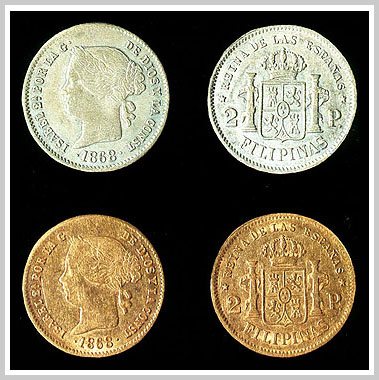

|
|
|
|
|
|
|
|
|
1861 - 1885 
Top row shows the obverse and reverse of an unusual Isabel II 2-peso coin dated 1868/? (re-cut 8?) struck on a greenish-white metal. Lower row displays the obverse and reverse of a coin struck on gold from exactly the same set of dies from which the former coin came. Both coins measure 18 mm. |
| Featured on
the top row are the obverse and reverse of a 2-peso coin dated 1868/? (re-cut
8?) struck on greenish-white metal which was found among some heirloom
coins in Roxas City, Capiz, West Visayas on March 3, 1978. As 2-peso coins
were supposed to have been struck on gold, this particular coin immediately
generated great numismatic interest as it appeared to be an EXTREMELY RARE
OFF-METAL STRIKE (OMS).
Tested at the Money Museum of the Central Bank of the Philippines on March 13, 1978, the coin weighed approximately 3.4 grams, registered a specific gravity of 17 and showed no reaction to nitric acid when it was tested on three different occasions. Having passed initial scrutiny, it was officially reported in the Central Bank numismatic publication Barrilla on October 1978 and has since been repeatedly exhibited at subsequent annual conventions of the Philippine Numismatic and Antiquarian Society (PNAS). The question that has remained unanswered until recently however, is whether or not this coin, which has been affectionately called ISABEL BLANCA, was one of those contemporary counterfeits (falsas de epoca) made for gain from spurious dies in private mints. On September 1, 1981, on the PNAS convention floor at the Holiday Inn in Manila, a regular 2-peso 1868 coin was found that laid all of these speculations to rest (obverse and reverse shown on the lower row of the photograph). Microscopic comparison of the two coins confirmed without doubt that both coins had come from the SAME set of OFFICIAL dies of the Case de Moneda de Manila. But why was the BLANCA ISABEL coined at all? Was it authorized? An error? A trial piece?. A presentation piece? Was the mint employee's purpose to gild it and fraudulently pass it on as a regular coinage? Whatever be the initial reason for its existence, does it not stand to reason that there should at least be a few more pieces just like it waiting to be discovered? Only ONE specimen known to exist. (Philippine collection) |
|
|
|
|